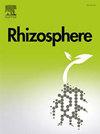Funneliformis mosseae exhibits greater improved effects on root hair development and phosphorus uptake in trifoliate orange than Claroideoglomus etunicatum
IF 3.4
3区 生物学
Q1 PLANT SCIENCES
引用次数: 0
Abstract
Low-phosphorus (P) soils significantly limit agricultural productivity globally, particularly in regions where fertilizer application is restricted. Root hairs are crucial for the absorption of water and nutrients, while arbuscular mycorrhizal fungi (AMF) offer a promising approach to improve both root development and nutrient uptake. However, the molecular mechanisms by which specific AMF species affect root hair development in trifoliate orange (Poncirus trifoliata), a key citrus rootstock, are not well understood. In this study, the effects of Funneliformis mosseae (F. mosseae) and Claroideoglomus etunicatum (C. etunicatum) on root hair development, nutrient levels, and the expression of associated genes in trifoliate orange seedlings were studied. Both F. mosseae and C. etunicatum established symbiotic structures in the roots, but F. mosseae elicited a more pronounced response, as evidenced by enhanced plant growth, root development, root hair density, and length under F. mosseae versus C. etunicatum. Additionally, the two fungi increased phosphorus content and indole-3-acetic acid (IAA) levels, enhanced acid phosphatase activity, and reduced IAA oxidase activity, although C. etunicatum had a lesser effect on root IAA oxidase activity. The two fungal treatments upregulated the expression of PtPAP1, PtaPT1, and PtaPT5, while its down-regulated the expression of PtPAP15, PtEXPA2, and PtEXPA4. Correlation analysis revealed that PtPAP1, PtaPT1, and PtaPT5 positively influenced root hair formation, while PtPAP15, PtLAX5, PtABCB15, and PtPIN1 had negative effects on root hair formation. Overall, under low-phosphorus conditions, F. mosseae outperformed C. etunicatum in promoting root hair development and phosphorus uptake in trifoliate orange, driven by enhanced colonization, elevated IAA levels, and upregulated phosphate transporter genes. These findings highlight F. mosseae's superior potential for optimizing root architecture and nutrient efficiency in citrus rootstocks.
对三叶橙根毛发育和磷吸收的促进作用,苔藓漏斗形菌优于尾状云雀
低磷土壤严重限制了全球农业生产力,特别是在限制施肥的地区。根毛对水分和养分的吸收至关重要,而丛枝菌根真菌(AMF)为改善根系发育和养分吸收提供了一种有希望的途径。然而,特定AMF物种影响三叶橙(Poncirus trifoliata)根毛发育的分子机制尚不清楚。本研究以三叶橙幼苗为材料,研究了mosseae (F. mosseae)和etunicatum Claroideoglomus etunicatum (C. etunicatum)对三叶橙幼苗根毛发育、营养水平和相关基因表达的影响。两种真菌均在根内建立了共生结构,但苔藓真菌对植物生长、根系发育、根毛密度和长度的影响更为明显。此外,两种真菌均能提高磷含量和吲哚-3-乙酸(IAA)水平,提高酸性磷酸酶活性,降低IAA氧化酶活性,但对根IAA氧化酶活性的影响较小。两种真菌处理均上调了PtPAP1、PtaPT1和PtaPT5的表达,下调了PtPAP15、PtEXPA2和PtEXPA4的表达。相关分析显示,PtPAP1、PtaPT1和PtaPT5对根毛形成有正向影响,而PtPAP15、PtLAX5、PtABCB15和PtPIN1对根毛形成有负向影响。总体而言,在低磷条件下,在定植增强、IAA水平升高和磷酸盐转运蛋白基因上调的驱动下,F. mosseae在促进三叶橙根毛发育和磷吸收方面优于C. etunicatum。这些发现突出了F. mosseae在优化柑橘砧木根系结构和养分效率方面的优势潜力。
本文章由计算机程序翻译,如有差异,请以英文原文为准。
求助全文
约1分钟内获得全文
求助全文
来源期刊

Rhizosphere
Agricultural and Biological Sciences-Agronomy and Crop Science
CiteScore
5.70
自引率
8.10%
发文量
155
审稿时长
29 days
期刊介绍:
Rhizosphere aims to advance the frontier of our understanding of plant-soil interactions. Rhizosphere is a multidisciplinary journal that publishes research on the interactions between plant roots, soil organisms, nutrients, and water. Except carbon fixation by photosynthesis, plants obtain all other elements primarily from soil through roots.
We are beginning to understand how communications at the rhizosphere, with soil organisms and other plant species, affect root exudates and nutrient uptake. This rapidly evolving subject utilizes molecular biology and genomic tools, food web or community structure manipulations, high performance liquid chromatography, isotopic analysis, diverse spectroscopic analytics, tomography and other microscopy, complex statistical and modeling tools.
 求助内容:
求助内容: 应助结果提醒方式:
应助结果提醒方式:


